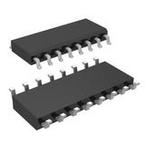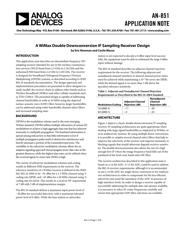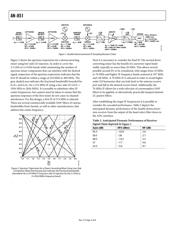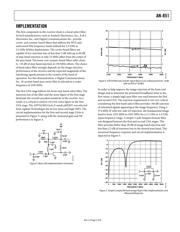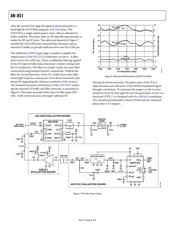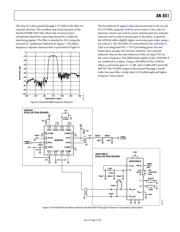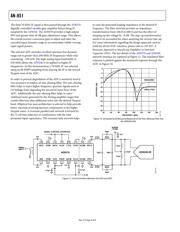herunterladen

AN-851
APPLICATION NOTE
One Technology Way • P.O. Box 9106 • Norwood, MA 02062-9106, U.S.A. • Tel: 781.329.4700 • Fax: 781.461.3113 • www.analog.com
Rev. 0 | Page 1 of 8
A WiMax Double Downconversion IF Sampling Receiver Design
by Eric Newman and Cecile Masse
INTRODUCTION
This application note describes an intermediate frequency (IF)
sampling receiver intended for use in the wireless communica-
tion services (WCS) band from 2.3 GHz to 2.36 GHz and the
unlicensed ISM band from 2.4 GHz to 2.48 GHz. The receiver
is designed for broadband Orthogonal Frequency Division
Multiplexing (OFDM) systems, as described according to IEEE
802.16 standards documentation. The design approach and
implementation procedures are presented to allow designers to
easily modify the receiver chain to address other bands such as
Wireless Broadband (WiBro) and other cellular standards such
as TDS-CDMA. The presented design is capable of addressing
channel bandwidths as wide as 10 MHz using the depicted
surface acoustic wave (SAW) filter; however, larger bandwidths
can be addressed using wider bandwidth channel-select filters
and increased sampling rates.
BACKGROUND
OFDM is the modulation scheme used in the next emerging
WiMax standard. OFDM utilizes multiple subcarriers of various IQ
modulations to achieve a high aggregate data rate that has inherent
immunity to multipath propagation. The baseband information is
spread among subcarriers so that little information is lost if
multiple propagation paths result in destructive interference and
heavily attenuate a portion of the transmitted spectrum. The
variability in the subcarrier modulation schemes allows for an
adaptive signaling approach that propagates lower data rates at the
greatest distances, while the highest data rates can be utilized when
the received signal-to-noise ratio (SNR) is high.
The variety of subcarrier modulation schemes and coding
results in different SNR requirements at the receiver. The
reference sensitivity of a WiMax receiver is defined in the IEEE
Std. 802.16-2004 to be −91 dBm for a 1.5 MHz channel using ½
coding rate QPSK, and −65 dBm for a 20 MHz channel using ¾
coding rate 64-QAM. This results in a receiver NF requirement
of 7 dB with 5 dB of implementation margin.
The 802.16 standard defines a maximum input power level of
−30 dBm for successful detection, with a maximum tolerated
power level of 0 dBm. While the base station or subscriber
station is not expected to decode a 0 dBm input level success-
fully, the equipment must be able to withstand the large 0 dBm
input without damage.
The 802.16 standard describes an adjacent channel rejection
requirement for the receiver. The following adjacent and
nonadjacent channel interferer to desired channel power ratios
must be achieved while maintaining a 10
−6
bit error rate (BER)
while the desired signal is no more than 3 dB above the
specified reference sensitivity.
Table 1. Adjacent and Nonadjacent Channel Rejection
Requirements as Described in the 802.16-2004 Standard
Modulation/Coding
Adjacent Channel
Rejection (dB)
Nonadjacent
Channel
Rejection (dB)
16-QAM-¾ −11 −30
64-QAM-¾ −4 −23
ARCHITECTURE
Figure 1 depicts a classic double downconversion IF sampling
receiver. IF sampling architectures are quite appropriate when
dealing with large signal bandwidths as employed in WiMax, or
even multicarrier systems. By using multiple down conversions,
it is possible to employ several channel select filters that help to
improve the selectivity of the receiver and improve immunity to
blocking signals that would otherwise degrade receiver sensitiv-
ity. The double downconversion also allows the use of a high
enough first IF where the image frequency band falls out of the
passband of the front-end, band-select RF filter.
The receiver architecture described in this application note is
based on a 14-bit ADC. A 12-bit ADC could be used to address
the 802.16 receiver requirements, although it is recommended
to use a 14-bit ADC for single-down conversion or for multicar-
rier architectures in order to compensate for the less efficient
selectivity and avoid the saturation of the ADC in presence of
high interferer levels. In order to design a receiver capable of
successfully addressing the multiple data rate options available,
it is necessary to select IF center frequencies carefully and
ensure that appropriate SAW filter selections are available.

